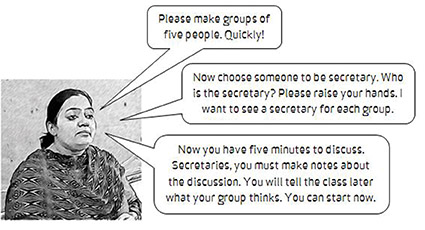3 Moving students towards speaking independently in discussions
As students become more confident at speaking in English, they can carry out activities such as discussions. These give your students opportunities to share and hear opinions. They also give your students the opportunity to speak more independently and express themselves in their own words.
You can do discussion activities with any class or level. Note, however, that you need to choose topics that are appropriate to the level and age of your students, and give more language support to students whose English is weaker. Here are ways in which you can support your students to participate in a discussion in English:
- Give your students something interesting to talk about. Discussions don’t always have to be about serious topics. If you allow students to choose the topic, they may find it easier to talk about, and they will probably be more motivated.
- Give the students some time to prepare what they want to say and the words or phrases that they might need (see the unit Building your students’ confidence to speak English).
- Use small groups where students can support each other. Within the groups, encourage all students to contribute, but don’t expect students to contribute equally to every discussion.
- Keep the discussion short, and don’t expect students to talk at length. Walk around the room and listen as students carry out the activity. If you note that most students have finished, end the activity. It is always better to end an activity before the students have quite finished rather than lettingit drag on for too long. If an activity lasts too long, students become bored and unfocused.
- It can help students to focus and concentrate on the discussion if they know that they are doing something with their ideas later, for example giving a report or a presentation. So you may want to vary your activities by following a discussion activity with a writing activity.
Case Study 3: Ms Aruna directs discussions in small groups
Ms Aruna teaches English in a secondary school. She reflects on how she tried to engage her students in a discussion in English by having them choose the topic.
I teach Class X and in the textbook there are often suggestions for discussions. My students used to find discussions very difficult. I would ask them a question and then ask them to say what they thought. One or two would stand up and give some opinions and then sit down. To be honest, it was always the same students. The others would not express an opinion.
In the end, I would write some sentences on the board for students to say, such as ‘I think it is right to kill animals to save a human being’, or ‘In my opinion, it is not right to kill animals to save a human being’. But I knew that they were just reading my sentences aloud, and not even giving their real opinions. This approach was not really developing their speaking skills.
I decided to try a new approach. I asked my students for some topics that they would like to discuss. We wrote a list on the board and we chose one: ‘Which is the best TV serial on today? Why is it the best? Is it good – or bad – for young people to watch TV serials?’
I wrote some phrases on the blackboard that students could use to express an opinion, and to agree or disagree with each other:

Then I gave the students two or three minutes to make notes of what they wanted to say. I encouraged them to write notes only and not to write a text. Then I gave the students some further instructions:

As students discussed, I moved around the room and listened to the discussions. I didn’t join in or correct their mistakes. The discussions were very interesting! I listened to two groups and I made some notes about grammar and pronunciation mistakes.
After five minutes I stopped the discussion and I asked the secretary of some of the groups to give a short report of the discussion to the whole class. Usually students don’t really listen much when others are reading out or speaking, but this time they were all interested to see what everyone thought about their favourite TV serial!
At the end of the class, I reviewed the grammar and pronunciation mistakes. I wrote words that students had pronounced incorrectly on the board, and asked them to repeat the words after me. Then I wrote some sentences with mistakes that the students had made on the board, and asked them to find the mistakes and write the correct sentences in their notebooks.
The students enjoyed the class, and they spoke much more using this approach. Next time, I plan to follow up the discussion with a writing activity so that students can have more time to develop their ideas about the topic.
Activity 4: Try in the classroom – supporting students to participate in group discussions
Follow these steps to carry out group discussions with your students:
- Ask your students to share ideas about a topic to discuss. Write the ideas on the blackboard and ask the students to select a topic, for example by raising their hands to vote.
- Write some useful phrases on the blackboard, including vocabulary if necessary. Give your students a few minutes to make notes about the topic. This gives them time to prepare what they want to say and the words they need. Walk around the room and help students who need it.
- Organise your students into small groups of, say, four or five. Ask each group to choose a secretary who will make notes during the discussion.
- Tell your students to discuss the topic. Give them a short time limit.
- As students discuss, listen to as many groups as you can. You can make notes about their use of English if you like. Try not to interrupt or correct students – you can correct mistakes later.
- When the time is up, tell the students to stop.
- Ask the secretary in each group to give a report on the discussion.
- Give students some feedback about the reports. Respond to what students have said, and remember to be positive. You can deal with mistakes at the end of the activity in another class.
Pause for thought Here are some questions for you to think about after trying this activity. If possible, discuss these questions with a colleague.
|
Remember that speaking in another language is difficult for many students. Be encouraging and give positive feedback. Some students will need more support than others. You can give these students more words and phrases, more time to plan and prepare, or put them with classmates who can help them.
2 Creating opportunities for real-life communication in English
